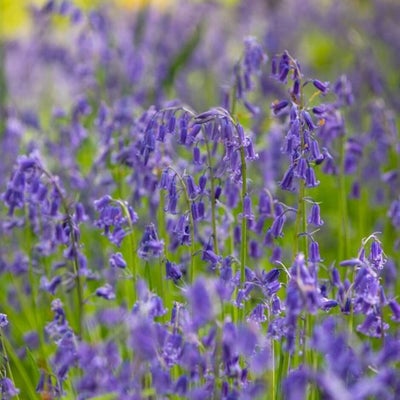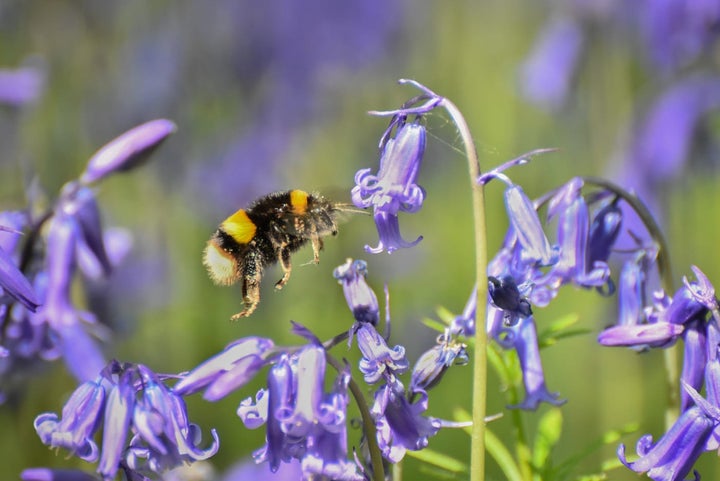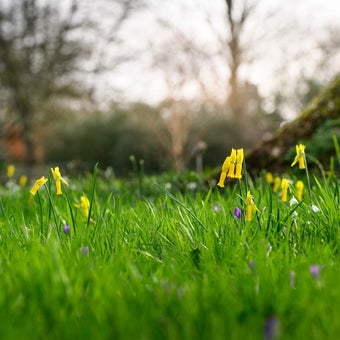
Quick facts
The botanical name for our native English bluebell is Hyacinthoides non-scripta
The botanical name for Spanish bluebell is Hyacinthoides hispanica
Bluebells are bulbous perennials, flowering in late spring and in leaf during spring and summer
If you need to control bluebells, non-chemical methods are effective, though it can take years to eradicate established clumps
What do bluebells look like?
At first glance, it can be hard to tell whether you have English or Spanish bluebells growing in your garden. However, on closer inspection, there are several distinguishing factors:
English bluebells – our bluebell grows to about 40cm (16in) in height and bears deep violet-blue flowers (very occasionally pink or white) with petals curled back at the mouth of the bell. The flowers are on one side of the arching stems and have a delicate, sweet scent. The narrow, strap-shaped green leaves are about 1.5cm (½in) wide.
Spanish bluebells – flowers are a lighter blue and are larger than those of English bluebells. They are unscented and are positioned all the way around upright stems. Pink or white flowers sometimes occur, and as with English bluebells, these have been selected and bred to produce pink or white-flowered cultivars. The strap-shaped green leaves are about 3cm (1¼in) wide.
It is harder to correctly identify hybrids of the two (Hyacinthoides × massartiana), as they naturally vary in appearance, displaying a range of characteristics from both parent species. If you’re an RHS member and are unsure of what type of bluebell is growing in your garden, you can use the RHS Gardening Advice service to get your plants identified.
It isn’t important to correctly identify your bluebells if you’re just wanting to control or remove them, as the same methods are used for all three types.

Did you know?
All parts of the plant are toxic and the sap can cause skin irritation, so it is advisable to wear gloves when handling bluebells.
Are bluebells weeds?
Woodland floors carpeted with bluebells are appreciated for their natural beauty, with many people visiting bluebell woods in mid- to late-spring. The flowers can attract bees and butterflies, including the brimstone, orange-tip and pearl-border fritillary. As a source of nectar in spring, bluebells are a useful addition to wildlife gardens. They can also provide good ground cover in spring and summer, particularly under trees and shrubs.
However, bluebells spread readily by seed and bulb offsets (small, immature ). Ripe seed generally lands and germinates close to the parent plant. In favourable growing conditions, English, Spanish and bluebells will slowly but steadily spread to form dense clumps, potentially smothering smaller plants. In Northern Ireland and the Republic of Ireland, Spanish bluebell is listed as an invasive non-native species.
What is a weed?
The term ‘weed’ describes a plant that is growing where it isn’t wanted. Weeds usually thrive in average garden conditions, reproducing and spreading easily. It is up to you to decide what you call a weed and what you choose to retain or remove.
Are Spanish bluebells a threat to English bluebells?
In gardens close to wild, English bluebell populations, Spanish and bluebells are considered less desirable due to concerns over competition and hybridisation threatening the native bluebell population. If your garden is close to a wild population (such as a local woodland), then it is best to avoid planting Spanish and hybrid species, to prevent pollinators transferring pollen and causing hybridisation.

Top Tip
Pick bluebells from your garden and use indoors for a long-lasting cut flower display. Picking and deadheading some of the flowers from your garden will prevent self-seeding and help control their spread.
Frequently asked questions about controlling bluebells
Here are our answers to your most common questions about dealing with bluebells:
How invasive are bluebells?
Bluebells grow well in sun or shade, in a range of soil conditions. They spread by seed and offsets and can grow up through other plants. If left unchecked, clumps can easily spread beyond their allotted space and present unwanted competition to garden plants.
Do I need to get rid of bluebells?
No – you don’t need to get rid of bluebells as they can be useful garden plants and benefit . However, as bluebells can smother and outcompete other plants, it is usually necessary to regularly control their spread.
If you like bluebells but are concerned about them spreading through borders, grow them in a container and deadhead spent flowers to prevent them spreading by seed.
What is the easiest way to kill bluebells?
If you have bluebells growing where they aren’t wanted, there are a few methods of control:
- Dig out whole clumps – use a spade or garden fork to dig up clumps and remove all the and underground parts, looking closely for small offset bulbs. Most bulbs will be in the top 20cm (8in) of soil but it is worth checking a bit deeper. Doing this when bluebells are in leaf allows you to identify where the bulbs will be underground. If bluebells are growing among other garden plants, record (with a photo or a marker in the ground) exactly where the bluebells are growing and remove the bulbs in autumn or winter when the plants are and will suffer less root damage. You may need to completely dig up plants, remove soil from around the roots to find and pick out bluebell bulbs, then replant into cleared soil.
- Fork out individual plants – where single, or just a few, bluebell shoots appear among clumps of other garden plants, carefully insert a hand fork to its full depth close to the shoot. Work the handle of the fork to loosen the bulb then, grasping the shoot, gently ease it out of the soil.
- Turf and mow – regularly mow lawns containing bluebells in spring and summer to weaken bulbs, prevent flowering and self-seeding, and eventually eradicate them. Laying turf over an area containing lots of bulbs and mowing regularly for several years is a good control option that minimises soil disturbance.
If an area contains a lot of bluebells, it may take several years of digging, forking out or regular mowing to eradicate them completely.
Top Tip
Dispose of bluebell bulbs by adding them to your green waste collection bin or taking them to your local garden waste site. Adding bulbs to your home compost bin isn’t recommended, as it may take them many years to rot down and you could inadvertently spread them around your garden in the resulting compost.
Should I use weedkiller?
No – bluebells are strongly resistant to weedkillers and it appears that no garden weedkiller is effective at controlling them. Although it can take a while to completely get rid of bluebells using non-chemical methods, they are the most effective option.








